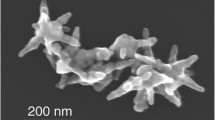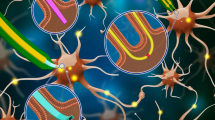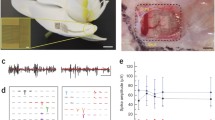Abstract
The application of nanoparticles in medicine requires a rigorous examination of their safety in order to determine and predict their benefits and potential side effects.
The aim of this study was to examine in vitro effects of coated silver-nanoparticles (cAg-NPs) on the excitability of single neuronal cells and to integrate those findings into an in silico model to predict their effects on neuronal circuits and finally on field potentials generated by those circuits.
As a first step, patch-clamp experiments were performed on single cells to investigate the effects of nano-sized silver particles surrounded by an organic coating. The parameters that were altered by exposure to those nanoparticles were then determined through using the Hodgkin & Huxley model of the sodium current. As a next step, to predict possible changes in network signaling due to the applied cAg-NPs, those findings were integrated into a well-defined neuronal circuit of thalamocortical interactions in silico. The model was then extended to observe neural fields originating from activity of neurons exhibiting Hodgkin & Huxley type action potentials. As a last step, the loop between field potentials and its generators was closed to investigate how the neural field potentials influence the spike generation in neurons that are physically located within these fields, if this feedback causes relevant changes in the underlying neuronal signaling within the circuit, and most importantly if the cAg-NPs effects on single neurons of the network are strong enough to cause observable changes in the generated field potentials themselves.
Access this chapter
Tax calculation will be finalised at checkout
Purchases are for personal use only
Similar content being viewed by others
References
Zhang Y, Satterlee A, Huang L (2012) In vivo gene delivery by nonviral vectors: overcoming hurdles? Mol Ther 20(7):1298–1304
Lamarre B, Ryadnov MG (2011) Self-assembling viral mimetics: one long journey with short steps. Macromol Biosci 11(4):503–513
Chithrani B, Ghazani A, Chan W (2006) Determining the size and shape dependence of gold nanoparticle uptake into mammalian cells. Nano Lett 6:662–668
Xu L, Zhao J, Zhang T, Ren G, Yang ZL (2009) In vitro study on influence of nanoparticles of CuO on Ca1 pyramidal neurons of rat hippocampus potassium currents. Environ Toxicol 24:211–217
Zhao J, Xu L, Zhang T, Ren G, Yang ZL (2009b) Influences of nanoparticles zinc oxide on acutely isolated rat hippocampal Ca3 pyramidal neurons. Neurotoxicology 30:220–230
Liu Z, Ren G, Zhang T, Yang ZL (2009) Action potential changes associated with the inhibitory effects on voltage-gated sodium current of hippocampal ca1 neurons by silver nanoparticles. Toxicology 264:179–174
Hodgkin AL, Huxley AF (1952) A quantitative description of membrane current and its application to conduction and excitation in nerve. J Physiol 117:500–544
Llinás R, Ribary U (1993) Coherent 40-Hz oscillation characterizes dream state in humans. Proc Natl Acad Sci U S A 90:2078–2081
Llinás R, Ribary U, Joliot M, Wang XJ (1994) Content and context in temporal thalamocortical binding. In: Buzski G et al (eds) Temporal coding in the brain. Springer, Berlin
Llinás R, Ribary U, Contreras D, Pedroarena C (1998) The neuronal basis for consciousness. Philos Trans R Soc Lond B 353:1841–1849
Llinás R, Leznik E, Urbano FJ (2002) Temporal binding via cortical coincidence detection of specific and nonspecific thalamocortical inputs: a voltage-dependent dye-imaging study in mouse brain slices. Proc Natl Acad Sci 99(1):449–454
Amari S (1977) Dynamics of pattern formation in lateral inhibition type neural fields. Biol Cybern 27:77–87
Busse M, Kraegeloh A, Arzt E, Strauss D (2011) Modeling the influences of nanoparticles on neural field oscillations in thalamocortical networks. Conf Proc IEEE Eng Med Biol Soc 2011:136–139
Pellegrino T, Manna L, Kudera S, Liedl T, Koktysh D, Rogach AL, Keller S, Rdler J, Natile G, Parak WJ (2004) Hydrophobic nanocrystals coated with an amphiphilic polymer shell: a general route to water soluble nanocrystals. Nano Lett 127:703–707
Koch M, Kiefer S, Cavelius C, Kraegeloh A (2012) Use of a silver ion selective electrode to assess mechanisms responsible for biological effects of silver nanoparticles. J Nanopart Res 14(2):646. https://doi.org/10.1007/s11051-011-0646-y
Fenwick EM, Marty A, Neher E (1982) A patch-clamp study of bovine chromaffin cells and of their sensitivity to acetylcholine. J Physiol 331:577–597
Kobayashi H, Shiraishi S, Yanagita T, Yokoo H, Yamamoto R, Minami S, Saitoh T, Wada A (2002) Regulation of voltage-dependent sodium channel expression in adrenal chromaffin cells: involvement of multiple calcium signaling pathways. Ann N Y Acad Sci 971:127–134
Tischler AS (2002) Chromaffin cells as models of endocrine cells and neurons. Ann N Y Acad Sci 971:366–370
Goldin AL, Barchi RL, Caldwell J, Hofmann F, Howe JR, Hunter JC et al (2000) Nomenclature of voltage-gated sodium channels. Neuron 28:365–368
Catterall WA, Goldin AL, Waxman SG (2005) International union of pharmacology. xlvii. nomenclature and structure-function relationships of voltage-gated sodium channels. Pharmacol Rev 57:397–409
Goldin AL (2001) Resurgence of sodium channel research. Annu Rev Physiol 63:871–894
Lorincz A, Nusser ZA (2010) Molecular identity of dendritic voltage-gated sodium channels. Science 328(5980):906–909
Royeck M, Horstmann M, Remy S, Reitze M, Yaari Y, Beck HA (2008) Role of axonal nav1.6 sodium channels in action potential initiation of ca1 pyramidal neurons. J Neurophysiol 100(4):2361–2380
Toledo-Aral JJ, Moss BL, He Z, Koszowski AG, Whisenand T et al (1997) Identification of pn1, a predominant voltage-dependent sodium channel expressed principally in peripheral neurons. Proc Natl Acad Sci U S A 94:1527–1532
Busse M, Stevens D, Kraegeloh A, Cavelius C, Vukelic M, Arzt E, Strauss D (2013) Estimating the modulatory effects of nanoparticles on neuronal circuits using computational upscaling. Int J Nanomed 8:3559–3572
Malmivuo J, Plonsey R (1995) Bioelectromagnetism. Oxford University Press, New York, NY
Price KV, Storn RM, Lampinen JA (2005) Differential evolution: a prictical approach to global optimization. Springer, Berlin
Shepherd GM (2001) The synaptic organization of the brain, 5th edn. Oxford University Press, Inc., Oxford
Jones EG (2002) Thalamic circuitry and thalamocortical synchrony. Philos Trans R Soc Lond B Biol Sci 357(1428):1659–1673
Singer W (1999) Neuronal synchrony: a versatile code for the definition of relations? Neuron 21(1):49–65
Hughes SW, Errington A, Lorincz ML, Kkesi KA, Juhsz G, Orbn G, Cope DW, Crunelli V (2008) Novel modes of rhythmic burst firing at cognitively-relevant frequencies in thalamocortical neurons. Brain Res 1235:12–20
Gray CM, Singer W (1989) Stimulus-specific neuronal oscillations in orientation columns of cat visual cortex. Proc Natl Acad Sci U S A 86:1698–1702
Ribary U, Ioannides AA, Singh KD, Hasson R, Bolton JPR, Lado F, Mogilner A, Llinás R (1991b) Magnetic field tomography of coherent thalamocortical 40-Hz oscillations in humans. Proc Natl Acad Sci U S A 8:11037–11041
Singer W (1993) Synchronization of cortical activity and its putative role in information processing and learning. Annu Rev Physiol 55:349–374
Gregoriou GG, Gotts SJ, Zhou H, Desimone R (2009) High-frequency, long-range coupling between prefrontal and visual cortex during attention. Science 324:1207–1210
Ribary U, Cappel J, Yamamoto T, Suk J, Llinás R (1991a) Anatomical localizaiton revealed by meg recordings of the human somatosensory system. Electroencephalogr Clin Neurophysiol 78:185–196
Gray CM, McCormick DA (1996) Chattering cells: superficial pyramidal neurons contributing to the generation of synchronous oscillations in the visual cortex. Science 274:109–113
Steriade M, Timofeev I, Drmller N, Grenier F (1998) Dynamic properties of corticothalamic neurons and local cortical interneurons generating fast rhythmic (30–40 Hz) spike bursts. J Neurophysiol 79:483–490
Brumberg JC, Nowak LG, McCormick DA (2000) Ionic mechanisms underlying repetitive high-frequency burst firing in supragranular cortical neurons. J Neurosci 20:4829–4843
Wang XJ, Golomb D, Rinzel J (1995) Emergent spindle oscillations and intermittent burst firing in a thalamic model: specific neuronal mechanisms. Proc Natl Acad Sci U S A 92:5577–5581
Wang XJ (1998) Calcium coding and adaptive temporal computation in cortical pyramidal neurons. J Neurophysiol 79:1549–1566
Golomb D, Shedmi A, Curt R, Ermentrout GB (2006) Persistent synchronized bursting activity in cortical tissues with low magnesium concentration: a modeling study. J Neurophysiol 95:1049–1067
Golomb D, Wang XJ, Rinzel J (1996) Propagation of spindle waves in a thalamic slice model. J Neurophysiol 75(2):750–769
Wang XJ, Buz’saki G (1996) Gamma oscillation by synaptic inhibition in a hippocampal interneuronal network model. J Neurosci 16(20):6402–6413
Destexhe A, Bal T, McCormick DA, Sejnowski TJ (1996a) Ionic mechanisms underlying synchronized oscillations and propagating waves in a model of ferret thalamic slices. J Neurophysiol 76(3):2049–2070
Bazhenov M, Timofeev I, Steriade M, Sejnowski TJ (1998) Cellular and network models for intrathalamic augmenting responses during 10-Hz stimulation. J Neurophysiol 79:2730–2748
Golomb D, Amitai Y (1997) Propagating neuronal discharges in neocortical slices: computational and experimental study. J Neurophysiol 78:1199–1211
Destexhe A, Contreras D, Sejnowski TJ, Steriade M (1994a) A model of spindle rhythmicity in the isolated thalamic reticular nucleus. J Neurophysiol 72(2):803–818
Destexhe A, Contreras D, Steriade M, Sejnowski TJ, Huguenard JR (1996b) In vivo, in vitro, and computational analysis of dendritic calcium currents in thalamic reticular neurons. J Neurosci 16:999–1016
Ferguson KA, Campbell SA (2009) A two compartment model of a ca1 pyramidal neuron. Can Appl Math Q 17(2):293–307
Destexhe A, Contreras D, Steriade M (1998a) Mechanisms underlying the synchronizing action of corticothalamic feedback through inhibition of thalamic relay cells. J Neurophysiol 79:999–1016
Bazhenov M, Timofeev I, Steriade M, Sejnowski TJ (2002) Model of thalamocortical slow-wave sleep oscillations and transitions to activated states. J Neurosci 22(19):8691–8704
Destexhe A, Mainen ZF, Sejnowski TJ (1998b) Kinetic models of synaptic transmission. In: Koch C, Segev I (eds) Methods in neuronal modeling, 2nd edn. The MIT Press, Cambridge
Wang XJ, Rinzel J (1992) Alternating and synchronous rhythms in reciprocally inhibitory model neurons. Neural Comput 4:84–97
Golomb D, Wang XJ, Rinzel J (1994) Synchronization properties of spindle oscillations in a thalamic reticular nucleus model. J Neurophysiol 72(3):1109–1126
Destexhe A, Mainen ZF, Sejnowski TJ (1994b) An efficient method for computing synaptic conductances based on a kinetic model of receptor binding. Neural Comput 6:14–18
Anastassiou CA, Perin R, Markram H, Koch CK (2011) Ephaptic coupling of cortical neurons. Nat Neurosci 14(2):217–223
Author information
Authors and Affiliations
Corresponding author
Editor information
Editors and Affiliations
Rights and permissions
Copyright information
© 2018 Springer Science+Business Media LLC
About this protocol
Cite this protocol
Busse, M., Salafzoon, N., Kraegeloh, A., Stevens, D.R., Strauss, D.J. (2018). Estimating the Effects of Nanoparticles on Neuronal Field Potentials Based on Their Effects on Single Neurons In Vitro. In: Santamaria, F., Peralta, X. (eds) Use of Nanoparticles in Neuroscience. Neuromethods, vol 135. Humana Press, New York, NY. https://doi.org/10.1007/978-1-4939-7584-6_10
Download citation
DOI: https://doi.org/10.1007/978-1-4939-7584-6_10
Published:
Publisher Name: Humana Press, New York, NY
Print ISBN: 978-1-4939-7582-2
Online ISBN: 978-1-4939-7584-6
eBook Packages: Springer Protocols




